
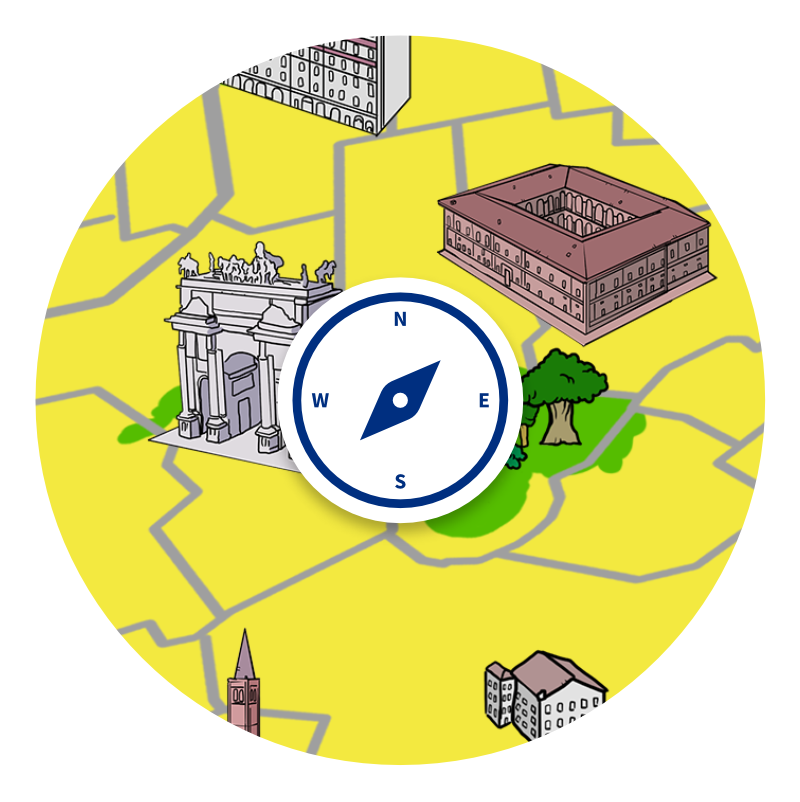 EXPLORE THE MAP
EXPLORE THE MAP
A city tour
How many times have you wanted to know more about a place or a monument? Search all the QR codes around the city or just browse this page and take a virtual tour between Milan today and Milan to come. Have fun discovering all the curiosities you did not know.
CA’ DI FACC
You’re now in front Cà di Facc (meaning ‘House of Faces’ in Milanese dialect), which was built in the early 20th Century in the typical “casa di ringhiera” style (a residential building with full-width balconies) for the middle class of the era. If you look up, you’ll see that there are many faces over the windows on the first, third and fourth floors of this enormous building. But whose are all these faces? Here's a hint: there are politicians, painters, writers, princesses and musicians among them. And how many are there? You’ll certainly be able to recognise a few of them for yourself because, among others, there’s Alessandro Manzoni, Leonardo Da Vinci, Raffaello Sanzio, Carlo Porta and Giuseppe Garibaldi. In all, there are 51 faces depicted on this building!
How many did you manage to recognise?
But this isn’t the only building in Milan with this feature.
It was a somewhat strange fad which began in Milan in the 1860s, when a proprietor decided to embellish his building in Corso Venezia with hundreds of statues, quotations and faces in red terracotta, earning it the name Cà Rossa (the Red House). The idea was so popular that there was even a catalogue of faces available for decorating your residence.
Other examples of these “Case Parlanti” (Speaking Houses) include Casa Manzoni in Piazza Belgioioso.
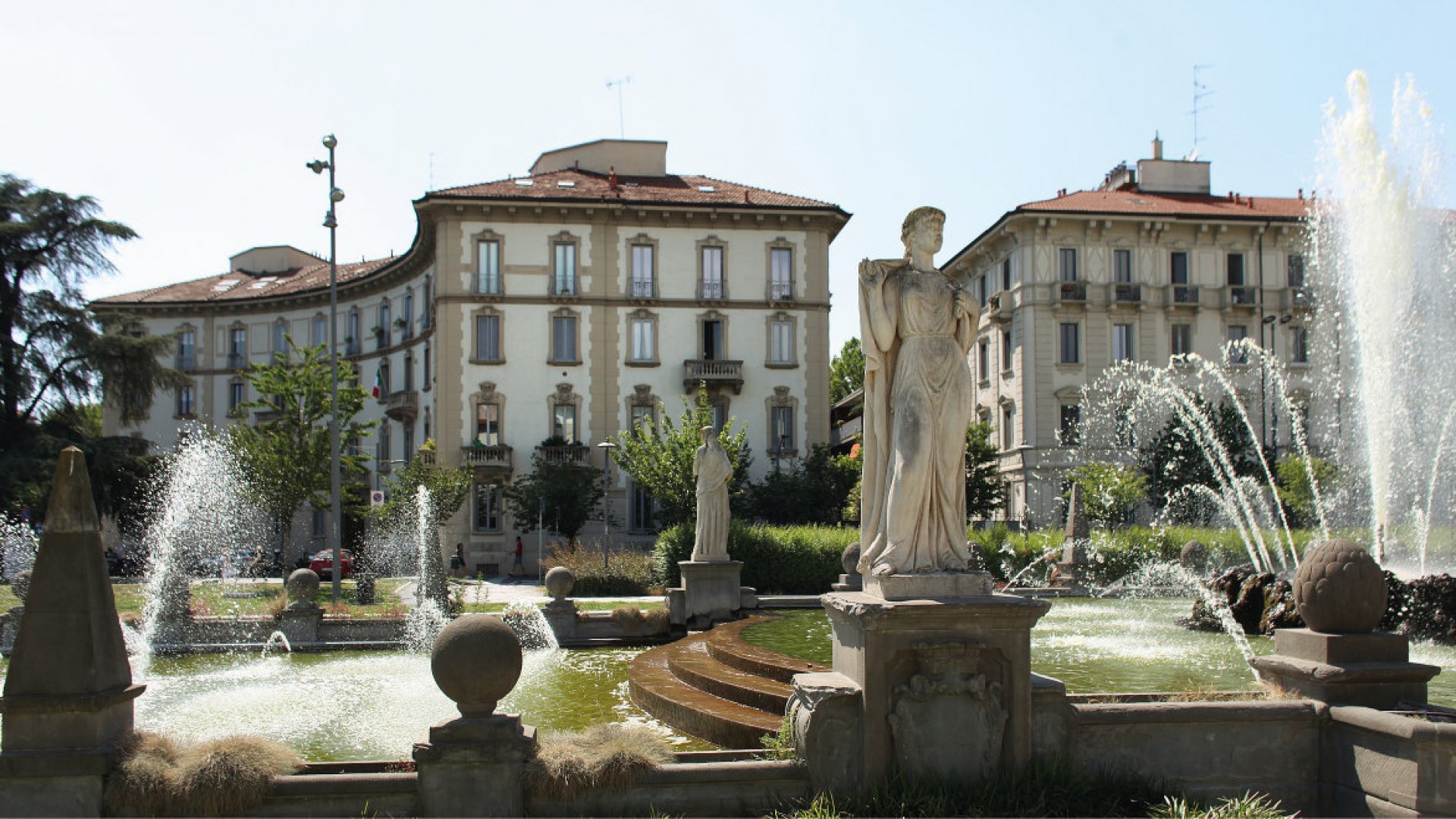
La Fontana delle quattro stagioni
You’re in Piazza Giulio Cesare, a square so expansive and majestic that, in the early 20th Century, it was also known as “the new Piazza d’Armi”. There are countless fountains in Milan, but this one is a little more special than all the others.
It isn’t all that well known, which is why we chose to give it the attention it deserves.
Fontana delle Quattro Stagioni (the “Fountain of Four Seasons”) was inaugurated in 1927 during the opening ceremony of the eighth International Fair (which was relocated to Rho in the early 2000s), and was designed to capture rainwater during storms. The four statues you see represent the four seasons. Impressive plumes of water reaching 8 metres in height spout from jets situated in the island in the centre of the basin. This is made possible by a water recirculation system which was already envisaged in the original design and was recently restored to coincide with major architectural works in this area - the results of which are immediately clear as soon as you look up, with three magnificent towers (to which this district now owes its name “Tre Torri”) and ultra-modern buildings inspiring the imagination of every passer-by.
But for a truly magical sight, you have to see the fountain at night, when you’ll be enchanted by a breath-taking play of water and light!
This is also what makes Milan so great: even in a completely new district you can still find a masterpiece like this which, even though it’s almost a century old, still looks perfectly at home.
Did you know that Piazzale Loreto will also soon be given a fresh new look? Find it on our map!
Santa Maria delle Grazie al Naviglio
No, you didn’t read that wrong - there really are two churches called Santa Maria delle Grazie in Milan, and the one you’re looking at here is known as the “al Naviglio”.
The church of Santa Maria delle Grazie al Naviglio has a five-hundred-year history. It all started in 1556 with the construction of a chapel with the image of the Madonna. This was demolished in the year 1700 to make room for a larger church in the Baroque style, but the story doesn’t end here. Destroyed by fire in 1717, the church was restored and extended further in the early 20th Century according to a project by a renowned Milanese architect who was also responsible for many other works, the most important of which being the church of Santa Maria degli Angeli e San Francesco (in Piazzale Velasquez), the pronaos of the Basilica di San Lorenzo (in Corso di Porta Ticinese) and the façade of the church of San Babila.
But going back to the subject of the church of Santa Maria delle Grazie al Naviglio, very few people know that its appearance today is not as the architect originally intended. It is in fact a church with no façade, while the original project had envisaged a series of spires containing statues and other finishing details.
An interesting fact: four of the eight columns now inside the church were originally created for the four-sided portico of San Paolo Outside the Walls in Rome. How is this possible? The church of San Paolo was also destroyed by a fire. It was chosen to use granite from the Montorfano quarry on Lake Maggiore to construct the 146 columns needed for the reconstruction project. This entailed a slow and lengthy journey to Rome by barge, with the granite transported from the River Toce to Lake Maggiore and then via the River Ticino and the Naviglio Grande canal to Milan, where the columns were carved at a stoneworking plant before continuing the long journey to Rome. As the barges passed in front of the building site of the church on the Naviglio canal, the builders decided to join forces, and four columns were “donated” to the project for the Milanese church.
Nothing remains of the baroque origins of the church and, rather like the ongoing works on the Duomo cathedral conducted by the Veneranda Fabbrica del Duomo, further restoration work has continued even up until recent times. Let’s hope that sooner or later, the façade will eventually be finished!
Let’s continue now in our discovery of other fascinating parts of this city.
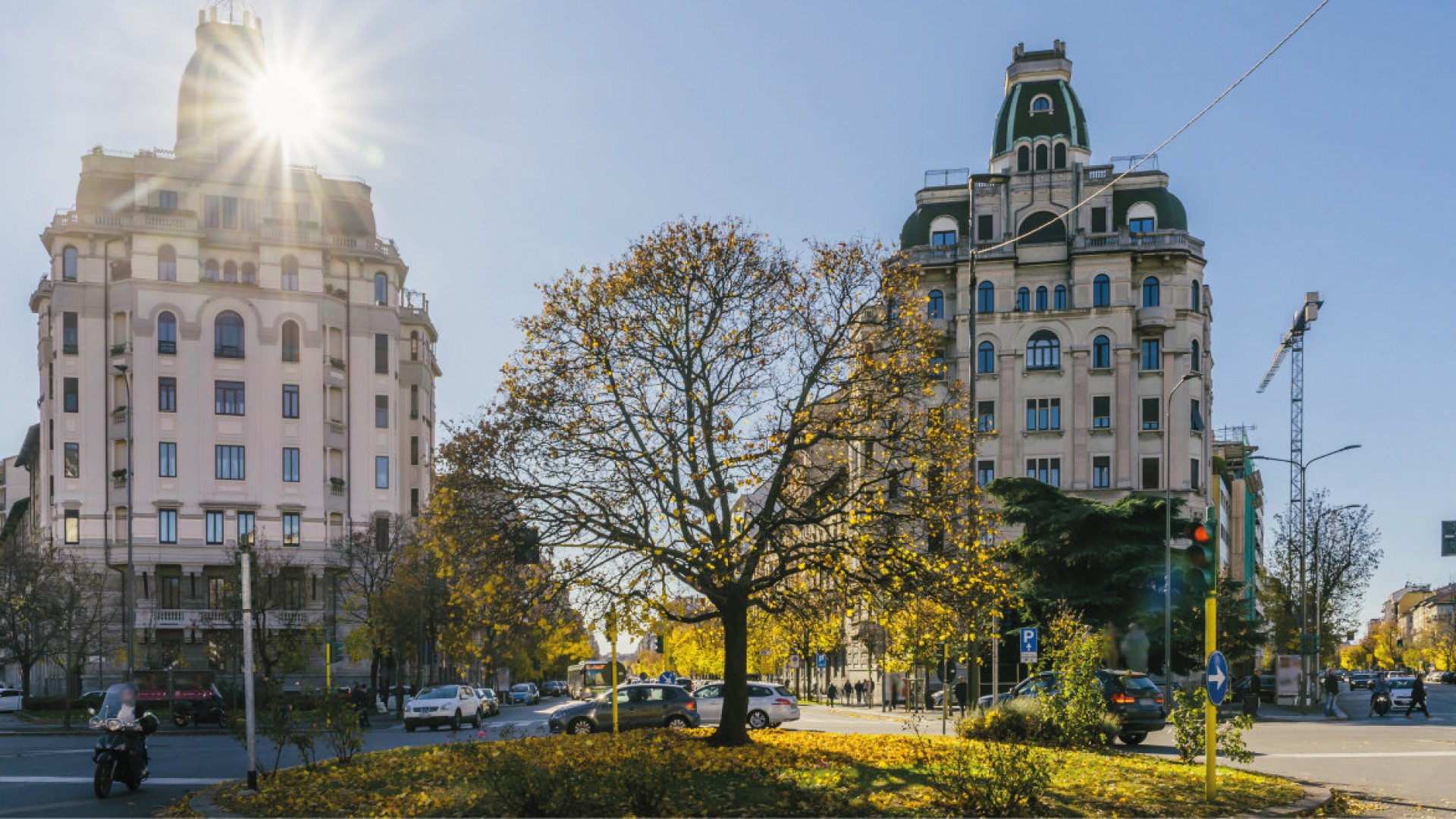
I Grattacieli Gemelli
Just look where you are now! Known as the Grattacieli Gemelli (Twin Skyscrapers), these two marvellous buildings are icons of the city. These were Milan’s first ‘skyscrapers’, and will be a hundred years old in 2023!
Building regulations were very different in those days, and so a special dispensation was necessary to make an exception to the city planning rules, according to which buildings were not permitted to exceed 28 metres in height. Standing approximately 40 metres tall, these buildings represented the start of the ‘New Milan’, a city aiming for new heights. It may seem a little funny nowadays to hear these buildings called ‘skyscrapers’, but at the time they were truly revolutionary.
Built in the timeless Beaux-Arts style, the two twins are in fact similar but different, and if you look at them carefully, you can see differences in the cupolas (colour aside) and in certain details of the façades.
Even though these buildings are a century old, they have nothing to envy their more modern successors and in fact, no contemporary skyscraper could hold a candle to them in terms of elegance!
These two buildings are situated in the residential part of the city, a zone considered to all intents and purposes as the ‘living space’ of its citizens, as it is home to many stately buildings, a famous theatre and countless shops and restaurants. Specifically, they are situated on opposite sides of Via Washington, in a position overlooking Piazza Piemonte, explaining why they are sometimes also referred to as the “Piazza Piemonte skyscrapers”.
Discover even more fascinating stories about Milan with us! Open the map and come and visit us!
Sant’Eustorgio
You’re in front of one of Milan’s most beautiful churches, with origins dating back many centuries: the Basilica di Sant’Eustorgio. This church actually stands on the ruins of an original Paleochristian church built in the 6th Century AD. The history of this church is even more breathtaking than its beauty!
Legend has it that the remains of the biblical Magi are kept right here in this church. The story starts in Milan in around the year 300 AD.
After passing hands from one family to another, the remains of the Magi ended up in Constantinople, where Emperor Constantine I decided to give them as a gift to the newly appointed bishop of Milan, Eustorgio I. Travelling in those days was neither easy nor comfortable, and, according to lore, when the relics reached Milan, the ox wagon transporting the ark used to carry them floundered in the wet and boggy terrain that once existed in the Ticinese area. Seeing this as a sign from Above, Eustorgio I decided to build what is now known as the Basilica di Sant’Eustorgio on this site, and to keep the ark holding the relics of the Magi here, where they remained until Milan fell to Barbarossa in 1164. Emperor Frederick I decided to relocate the relics from the devastated city of Milan to Cologne, but left the ark originally containing them in the Milanese Basilica. In spite of urging from bishops, cardinals and other leading figures of the clergy, it would be many centuries before the relics of the Magi would come back to Milan. Thanks to the efforts of Cardinal Ferrari, at least some of the relics made their way back to the Basilica in 1904. These are now kept in an urn on a dedicated altar, while the remaining relics are still in Cologne Cathedral.
Look up and you’ll see something very interesting! If you're still not convinced of the connection between the Basilica di Sant’Eustorgio and Caspar, Melchior and Balthazar, just look at the spire at the top of the bell tower and you’ll see an 8-pointed star instead of a traditional cross.
Did you know that the church of Santa Maria delle Grazie al Naviglio is not far from here? Discover it together with us!
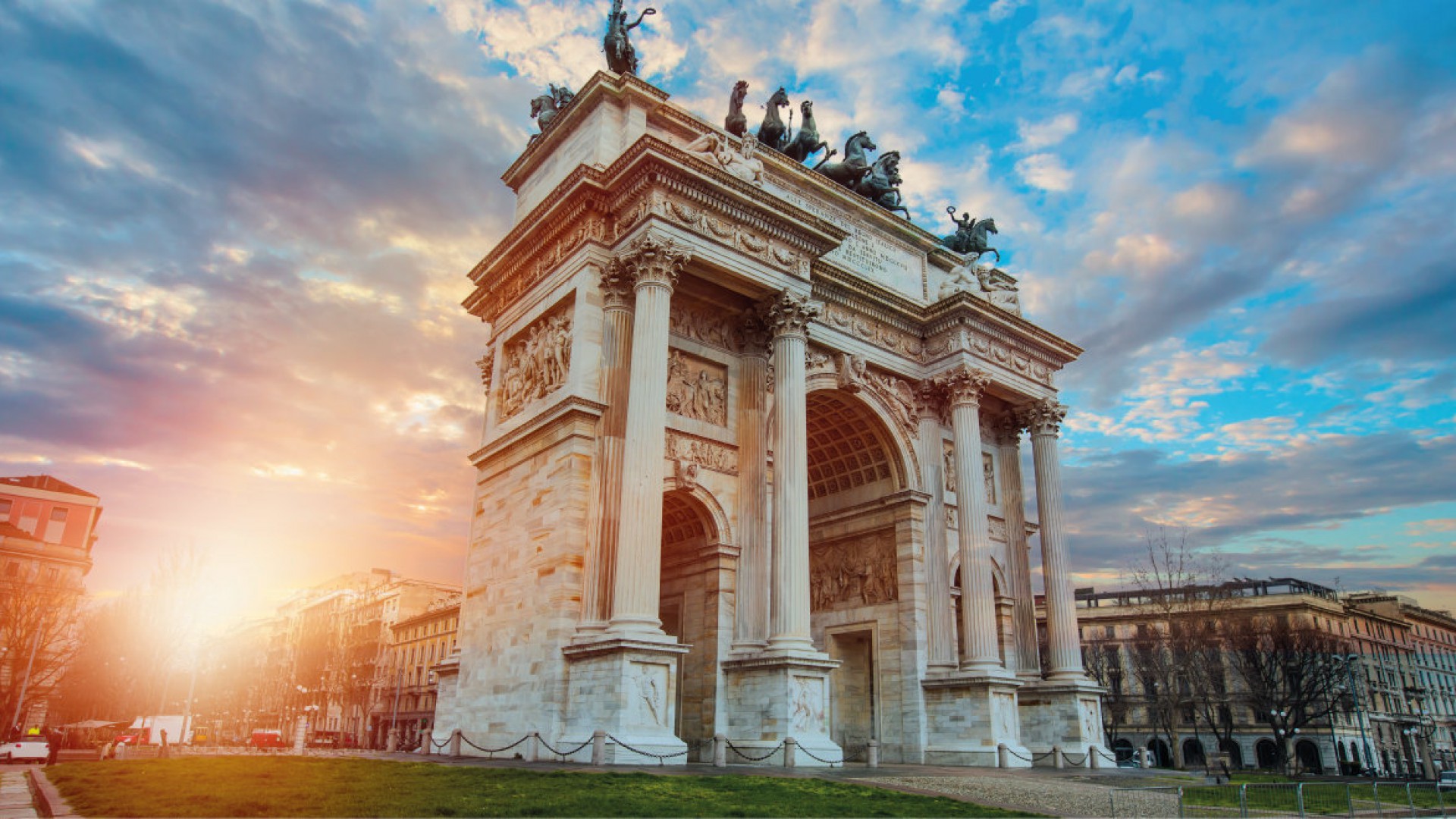
Arco della Pace
How many times have you stopped to really look at the Arco della Pace (Arch of Peace)? You're in front of nothing less than a spectacular monument built at the behest of Napoleon himself to commemorate his victories in battle. Did you know that the story behind this arch actually began in Porta Venezia in 1806, when Milan was under French rule?
A false arch made from wood was constructed in Porta Venezia in 1806 (the two toll house buildings did not exist at the time) to celebrate the marriage between the commander in chief of the army Eugène de Beauharnais and Princess Augusta of Bavaria, Duchess of Leuchtenberg.
The arch was so popular that it was decided to build one in marble at the start of Corso Sempione, as this road symbolically led to France. The significance of the arch changed from a celebration of triumph in war to one of peace on 8 June 1859, when the Arco della Pace became the symbol of independence of the city of Milan.
This is one of Milan’s most important neoclassical monuments and is still today second in size only to the Arc de Triomphe in Paris! Situated in the centre of the vast Piazza Sempione (which marks the beginning of Corso Sempione) and dominating the eponymous park sprawling expansively in front of the castle, the arch is also one of the five more recent new gateways to the city of Milan, earning it the name “Porta Sempione”.
The edifice is a triple-arched triumphal arch with 8 colossal fluted Corinthian columns (all carved from a single block of stone) and a central arch towering 14.24 metres in height constructed entirely from Baveno granite and clad in marble from Crevola d’Ossola. Perched right at the top of the arch is the “La Sestiga della Pace”, an enormous group of bronze statues. And if you look more closely, you’ll also see many other statues, bas-reliefs, festoons and vignettes on the sides of the arch. It’s truly magnificent, don’t you think?
Let’s continue now in our discovery of other fascinating parts of this city.
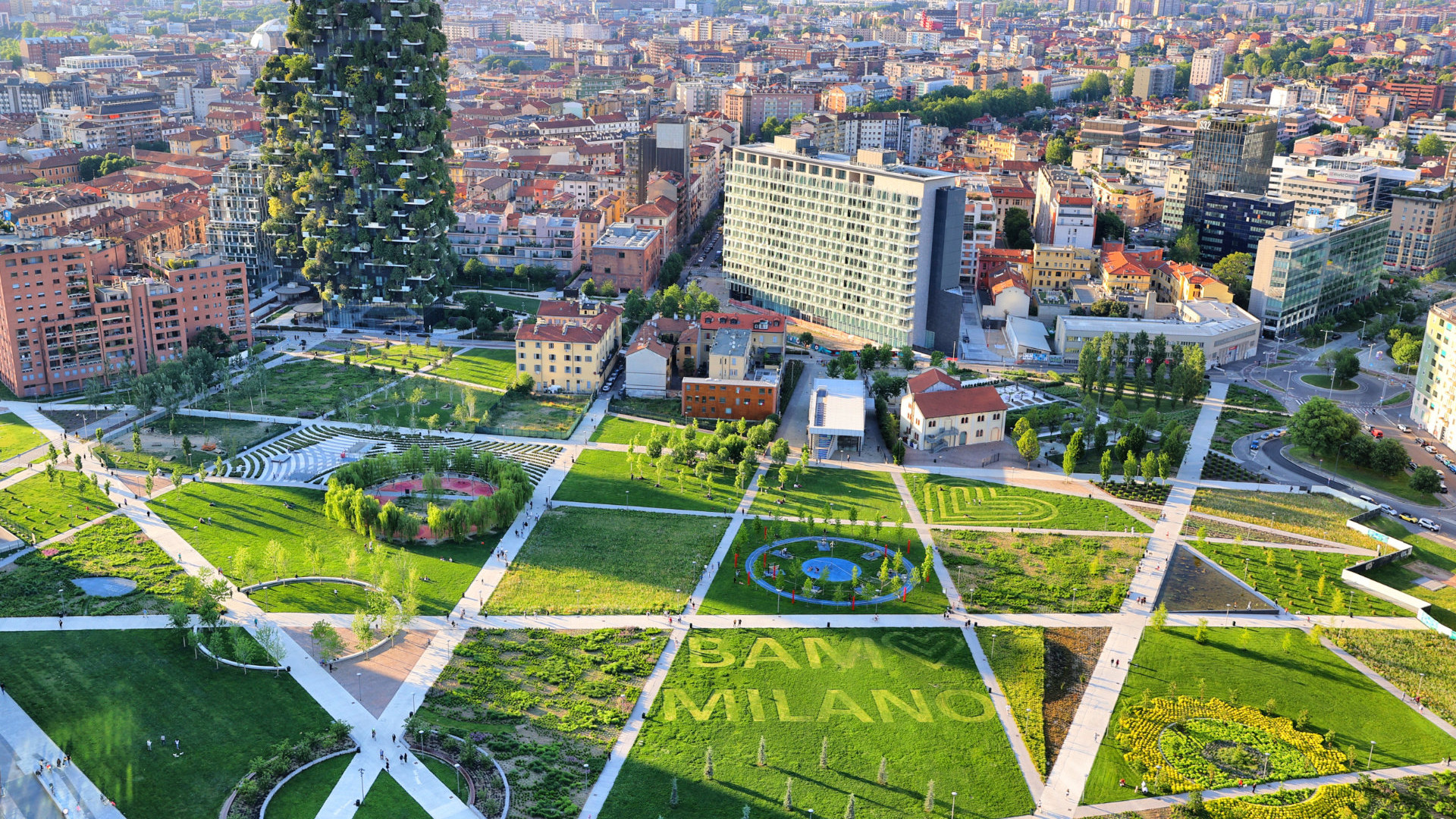

Welcome to BAM (Biblioteca degli Alberi Milano), a contemporary garden and cultural park conceived as an urban botanical ‘library’ and repository of an incredible wealth of plant life, with over a 100 species in all: with more than 500 trees forming 22 circular forests and 135,000 plants including aromatic herbs, hedgerows, shrubs, bulbs, creepers, aquatic plants and grasses.
A project of the Fondazione Riccardo Catella, BAM was inaugurated on 8 September 2019 with an open air concert by the Philharmonic Orchestra of La Scala which drew an audience of over 3000, testifying to the landmark status already earned by the new park, a green heart set against the city skyline. Spread over 10 hectares, BAM is a magical place where plants and winding footpaths intertwine to create a chequerboard of verdant spaces, irregular fields, circular forests, blooming pastures, little plazas and areas equipped with playground and fitness apparatus, and where even the avenues, paths and paving have been created with advanced, environmentally sustainable materials and techniques.
Biblioteca degli Alberi was designed by the Dutch studio Inside Outside|Petra Blaisse, and is also the only park in Italy created with the extensive involvement of the Dutch grand master of landscaping, Piet Oudolf, who is renowned for his gardens with a natural, wild appearance featuring spontaneous plants.
BAM is also an open air theatre, hosting over 200 cultural events each year dedicated to the link between nature and the arts in a programme curated by the cultural director of the park and a team of professionals. Titled BAMoments, these are inclusive events held all year round to celebrate the rhythms and seasons of nature, conceived to be experienced outdoors and inspired by the goals for environmental sustainability set for the year 2030 by the United Nations.
On Sunday 18 September at 20:00, don’t miss the fourth edition of Back to the City Concert – The greatest classical music in the park. This year, BAM will be hosting the Accademia Teatro alla Scala, which will be presenting a lyrical and symphonic programme. An unmissable event to be enjoyed while sitting on the grass in the open air of the park! For a front row experience, register as a BAMFriend, which offers priority access to the concert right at the foot of the stage.
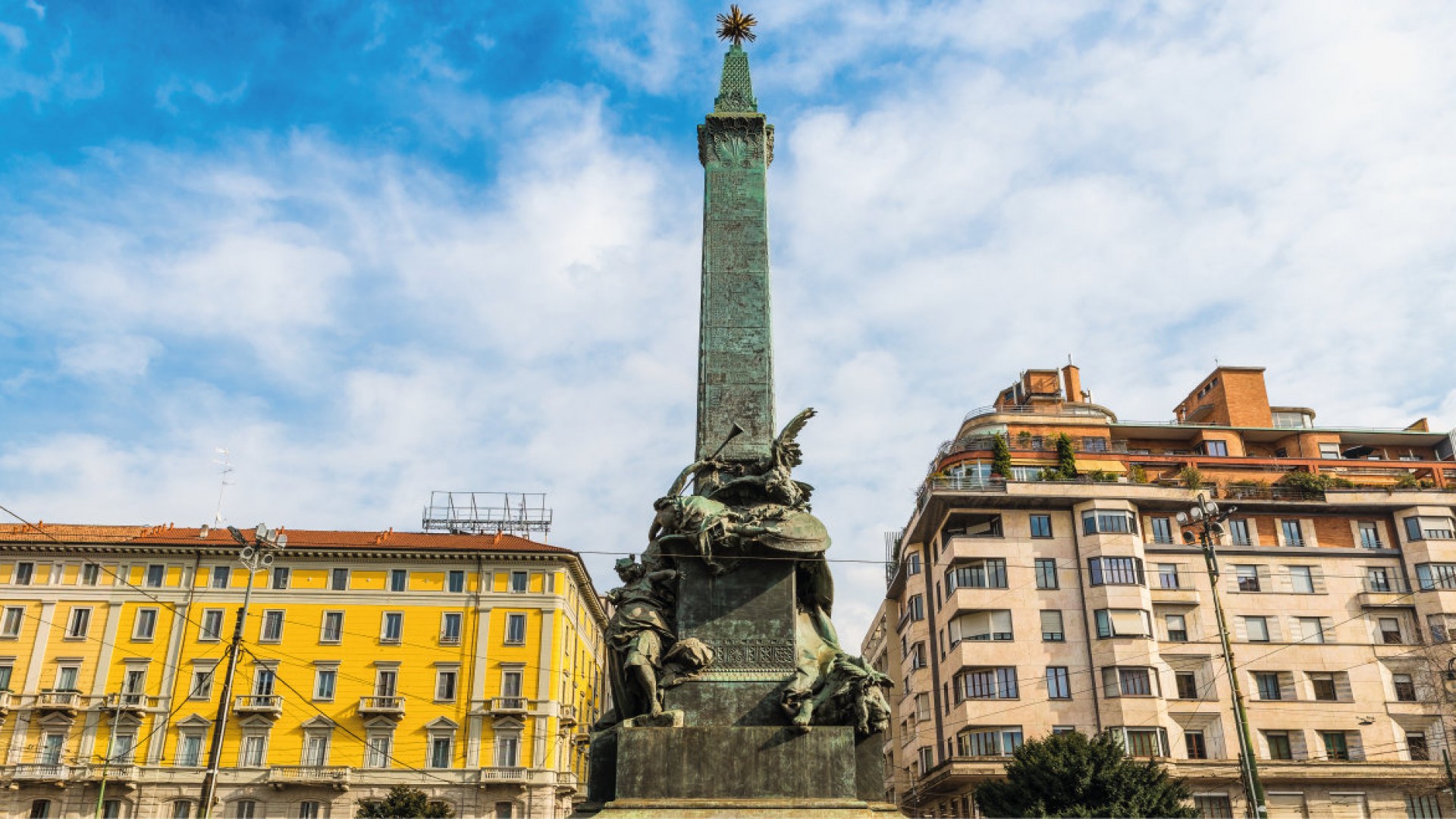
Monumento alle 5 Giornate di Milano
You’re standing in front of a monument dedicated to an unprecedented moment in history:
the Cinque Giornate di Milano (Five Days of Milan), an insurrection which took place from 18 to 22 March in 1848, in which the citizens of Milan opposed the invasion of the city by Austrian troops. In this spontaneous revolution, which resulted in the tragic death of 400 men, the Milanese succeeded in driving out the troops of General Radetzky, restoring the freedom of the city of Milan.
The first monument to commemorate the fallen of this insurrection was actually built in Piazza Duomo.
The monument you see here, on the other hand, was inaugurated 1895 and took 13 years to complete due to bureaucratic hold-ups and difficulties in casting the statues.
The artist used five female models to represent the actions and sentiments of each of the five days of the insurrection.
The first represents the call to battle, the second represents the cry of anguish in remembrance of the brutality suffered by the citizens at the hands of the Austrians, and the third embodies the rebelliousness and strength of the city. The fourth and fifth days are represented by two women wrapped in and supported by a light, fluttering flag: Milan is finally free again!
The sculpture also includes a lion and a golden eagle symbolising strength in defence and the uplifting concept of liberty.
This city has seen so many changes! Discover how much change has shaped this city with the Milan of tomorrow!
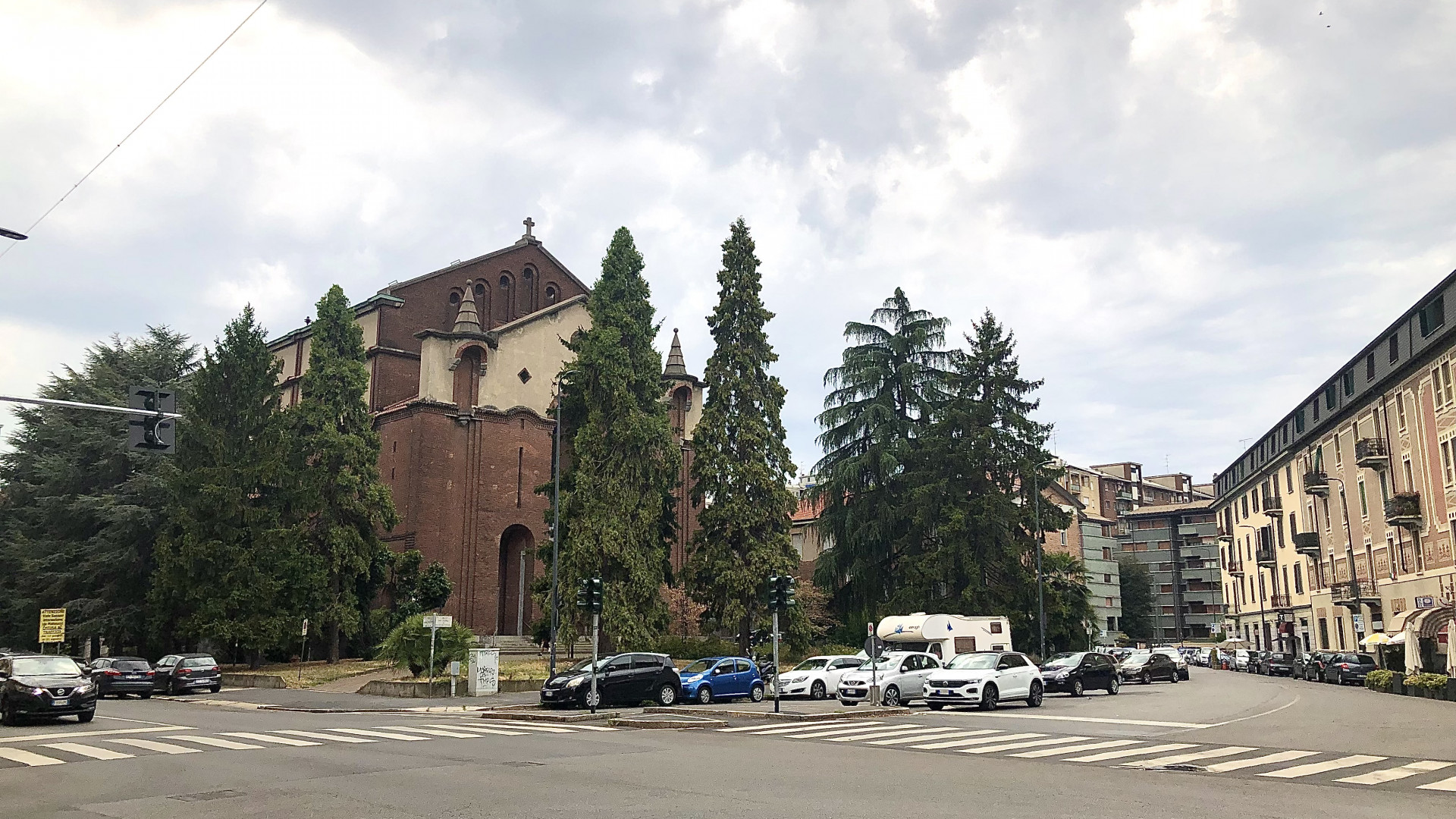
LARGO SAN DIONIGI IN PRATOCENTENARO
You’re in the Prato Centenaro quarter, an ancient district in the Niguarda zone which, it is said, is so named because it was once home to a centenarian - in the 18th century! This is now a densely populated zone of the city with many businesses, and whose streets are congested with heavy traffic, with both public transport and private vehicles alike. For years, the residents of this quarter have been asking the Municipality for a rejuvenated, liveable area for the community.
In September 2022, in piazza San Dionigi, near the parish church, a zone will be pedestrianised - albeit temporarily - to offer crucial new space for residents to socialise in complete safety. Like the project in Via Val Lagarina, this is also part of the Piazze Aperte initiative.
PIAZZALE LORETO – LOC
You're in a place which will look totally different by the end of 2026!
In view of the upcoming Milan-Cortina Winter Games in 2026, Piazzale Loreto will be transformed from a faceless site circled perpetually by traffic into a place that the residents of the city will be able to truly enjoy.
This will be LOC - Loreto Open Community, the project penned by Ceetrus Nhood which will give the city a new space for events and a new pedestrian zone, with trees, fountains and benches.
This will probably be the most revolutionary project for a square ever seen.
Piazzale Loreto will finally have a soul of its own and become an enjoyable space for both residents of the city and tourists.
There will still be cars, but only around the outermost part of the square. There will be plenty of lush vegetation and spaces dedicated to events, which will host concerts, markets, festivals and sports activities!
Milan is constantly becoming a greener city, so there will, naturally, also be cycle and pedestrian paths, electric charging points and bike sharing stations.
The project also envisages the construction of three new buildings roofed with green terraces for commercial, office and recreational use.
Soon, Piazzale Loreto will be a go-to venue for celebrations and events!
You’re going to love the Milan of tomorrow!
VIA VALFURVA
You’re in the vibrant Niguarda zone, a place which sets the pace for innovation and fresh new starts.
If everything goes according to plans, the restoration project for the Scarioni public swimming pool should soon begin here. The municipal authorities have opted for a joint public/private sector project intended to restore and bring the 28,000 square metre public baths - which have given the local Milanese residents so much joy over the years - back into operation as a multifunctional centre. The project will first restore the swimming baths in Via Valfurva, and then reopen the facility to the public.
The centre first opened in 1957. It was named after a football player who played for the Milanese Sempione team and later became a referee. Passionate about all sports, he organised a number of open swimming competitions and, in 1914, created the “Scarioni Cup”. This is why the municipality chose to name the swimming baths after him.
As well as the renovation project for the swimming baths, many other projects are also planned which will bring radical change to the district and create new spaces and services for citizens. For example, here in the same street, the site of the Municipal covered market, which has been out of use for several months, will be transformed into a Community house, a permanent health and social support centre where local citizens will be able to access primary and preventive healthcare services free of charge.
Discover even more fascinating stories about Milan with us!
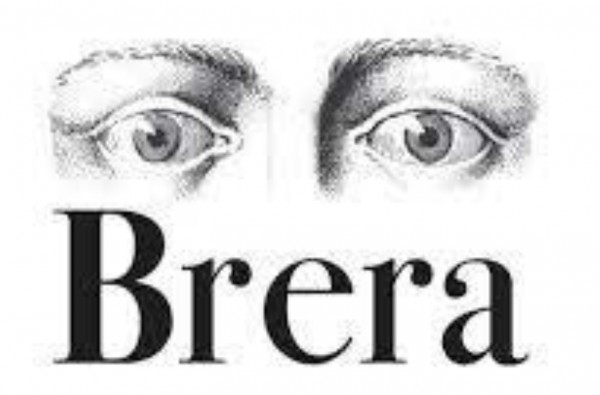
You’re in the bohemian quarter of the city, where you can visit the Pinacoteca di Brera. Founded in 1809 at the behest of Napoleon Bonaparte, this has always been one of the world's most famous museums.
As well as the Pinacoteca gallery, the Accademia di Belle Arti (academy of fine arts), the Braidense National Library, the Botanical Gardens and the Astronomical Observatory are also hosted within the walls of Palazzo di Brera.
The Pinacoteca is a jewel in the crown of the city, and thousands of visitors flock here every year to admire the art on display, which includes works by Piero della Francesca, Raffaello, Caravaggio and Francesco Hayez, the artist responsible for the world-famous "Il bacio”.
In the 1940s and 1950s, the Pinacoteca was the first world-class museum to have a female director:
the legendary Fernanda Wittgens. During the air raids in 1943, her actions saved many works of art both here and in other museums. She was a truly remarkable women - one of the many to have called Milan their home.
The Pinacoteca has many activities to offer, even for families with small children, such as:
read in the halls of the museum or listen to audio guides for adults and kids alike.
https://pinacotecabrera.org/proposte-educazione/didascalie-per-grandi-e-piccoli/
download lots of helpful material for organising a family visit to the museum
https://pinacotecabrera.org/educazione/tutte-le-proposte/
play games with Piera the satchel of the Pinacoteca di Brera. Ask for Piera at the info point of the museum
https://pinacotecabrera.org/proposte-educazione/il-museo-in-una-valigia/
try your hand at drawing in the museum. Build a drawing kit at home or pick one up at the info point of the Pinacoteca.
https://pinacotecabrera.org/proposte-educazione/come-costruire-un-kit-da-disegno/
read the guide created for persons with intellectual disabilities
https://pinacotecabrera.org/news-pinacoteca/pinacoteca-di-brera-museo-per-tutti/
Extensions
GUIDE NOTES FOR CHILDREN AND ADULTS
The guide notes available in the halls of the Pinacoteca for children and adults are created to be read or listened to together.
The content of these notes is devised to be easily understandable for all ages, with suggestions and activities to encourage discussion and sharing ideas.
https://pinacotecabrera.org/proposte-educazione/didascalie-per-grandi-e-piccoli/
HELPFUL MATERIAL
A huge choice of material put together by the educational department of the museum is available for downloading for organising visits for the whole family.
https://pinacotecabrera.org/educazione/tutte-le-proposte/
PIERA THE SATCHEL OF THE PINACOTECA
Piera, the satchel of the Pinacoteca di Brera and available from the info point of the museum, offers an innovative new way to experience a visit with the whole family. With special items, tools and suggestions for activities, the contents of the satchel have been devised to help family groups observe the exhibits, discover and play together.
https://pinacotecabrera.org/proposte-educazione/il-museo-in-una-valigia/
DRAWING KIT
The Pinacoteca recommends bringing a drawing kit - which you can build at home following the on-line instructions - with you to try your hand at drawing at the museum and to find out just how many things you can do with a sheet of paper and a pencil.
You can also pick up a ready-made kit from the info point of the Pinacoteca.
A number of Brera Drawing benches, complete with paper and pencils, are available in the halls of the museum where visitors are encouraged to copy the masterpieces on display or reinterpret them freely.
https://pinacotecabrera.org/proposte-educazione/come-costruire-un-kit-da-disegno/
A MUSEUM FOR ALL
The guide to the Pinacoteca for persons with intellectual disabilities and downloadable free of charge from the website is a tool created to offer an inclusive experience of the greatest masterpieces in the museum.
The guide is part of the “museum for all” project promoted by the association L’Abilità with the support of the De Agostini foundation, and was compiled in collaboration with the educational department of the Pinacoteca.
https://pinacotecabrera.org/news-pinacoteca/pinacoteca-di-brera-museo-per-tutti/
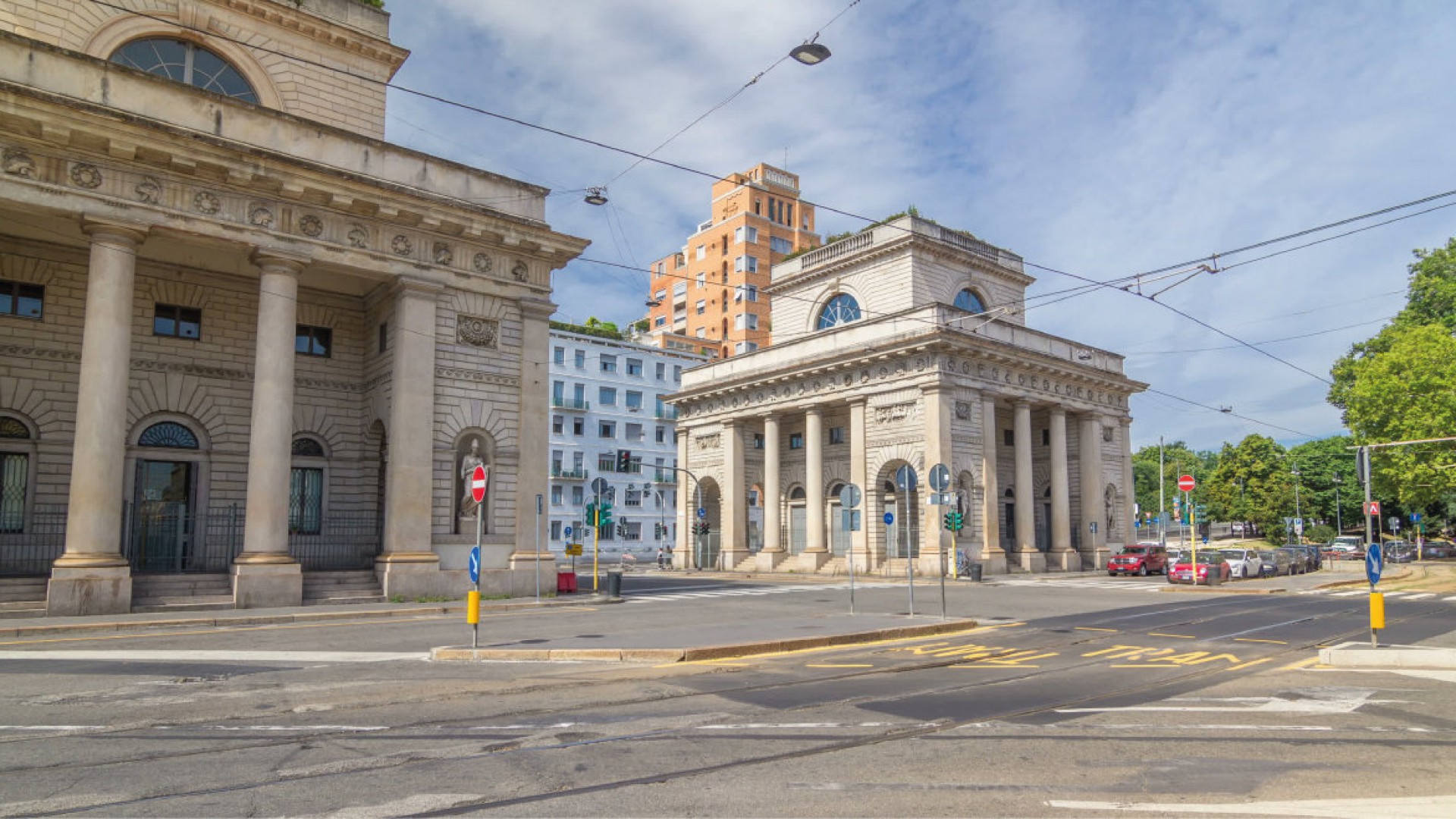
Dazi di Porta Venezia
Did you know that you once had to pay a toll to enter the city of Milan? Milan was surrounded by gates, and anyone entering through any of these gates had to pay a toll. In ancient times, these gate houses were linked by an actual gate demarcating the boundary between the countryside and the territory of the city. And no-one knew this better than Italy’s best-known Renzo of all, the character from the Promessi Sposi, who passed through this very gate to enter Milan in search of his beloved.
The gate houses we see today were designed between 1827 and 1828, and initially were not so popular among the residents of Milan. The two “cubes” perched on top of the toll houses were added later to make them taller. All the bas-relief adornments and statues were also added in later years.
In Roman and Medieval times and during the period of Spanish rule, this was the site of the gateway known for centuries simply as the Orientale (Eastern Gate), and which was only named Porta Venezia in 1860.
Today, the toll houses of Piazza Oberdan are very dear to the Milanese, perhaps because they are still perceived as the majestic gateway leading into the city centre via Corso Venezia, with the exuberance of Corso Buenos Aires behind you.
This toll house (the western toll house, to be precise), is now known as “Casa del Pane” (the House of Bread), as it hosts a library dedicated to food-related topics and, primarily, bread, and a museum which includes ancient bread-making machinery amongst its exhibits.
Do you know the other gates to the city of Milan? There are 13 of them in total: Porta Garibaldi, Porta Genova, Porta Lodovica, Porta Vercellina (or Magenta), Porta Romana, Porta Sempione (Arco della Pace), Porta Tenaglia, Porta Ticinese, Porta Venezia, Porta Vigentina, Porta Volta, Porta Vittoria and Porta Nuova!
Have you ever been to the Biblioteca degli Alberi library? Discover it together with us!
Via Val Lagarina
Did you know that this square is part of a major project named Piazze Aperte (“Open Squares”)?
The initiative originated a few years ago in New York as a way to involve the citizen in the realisation of small, experimental urban renewal projects in accordance with the “Tactical urbanism” approach. Milan took the ball and ran with it, immediately developing a project which gives citizens the opportunity to propose places to be made into traffic-free zones and given back to local residents as community spaces, turning them into piazzas in their own right.
38 projects like this have already been put into effect in the city, and there will be many more in future.
Here are all the projects completed to date and those now in the pipeline.
Around half of the 38 projects already completed (including this one, in Via Val Lagarina) involved the participation of the volunteers of the WAU! Milano association, which was awarded the Ambrogino d’Oro in 2019 and has been working for years to clean up the city.
Find out how to take an active part in change in your district!
Discover Milan’s “Case Parlanti” (Speaking Houses) with us!
VIA PADOVA - MARTESANA
Did you know that Milan is a city of water? Only a portion of the navigable canals crossing the city are uncovered, and up until the mid-20th century, the city looked quite different. You’re now near the Martesana canal, which is fed by the river Adda. Milan seen from the water is even more spectacular, with a truly international feel. And remaining in an international theme, you're also near Via Padova, a crossroads of different cultures and languages. To open the street up even further to opportunities for social interaction and cultural exchange, a wonderful renovation project is scheduled to start in the near future, which will give the street broader pavements and small plaza-like spaces dotted here and there, while the speed limit for traffic will be reduced to 30 km/h. There’ll also be more green, with 230 new trees - such as Greek strawberry trees, Ginkgo Biloba and magnolias - planted along the street. This has always been a culturally vibrant street, and in recent years, a number of projects have restored and given the city back the former swimming baths of Parco Trotter and the former Trotter boarding school, which is now home to the “Mosso” space.
The best description of Via Padova is probably the writing you can see over the Boulevard tunnel: “Via Padova Mondo” (Via Padova is the world)! The first new cultural initiative for the Tunnel was inaugurated a few months ago, consisting of an exhibition of poster art on topics related to the environment, society, literature and the arts.